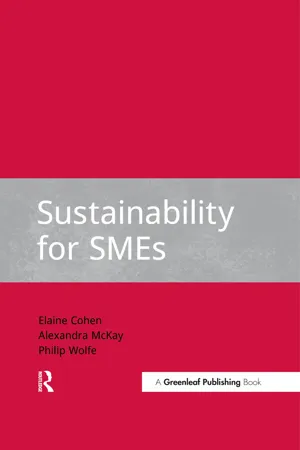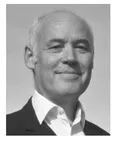![]()
Sustainable Energy Options for Business
Philip Wolfe
WolfeWare Limited
Abstract
THE MAJOR ENVIRONMENTAL IMPACT of most businesses derives from their energy usage. There are many ways in which organisations can improve the sustainability of their energy supply, and doing so is likely to have a huge positive impact on environmental footprint. Happily, there is another major upside. Using energy more responsibly improves profitability, unlike many other ethical decisions which can end up increasing a business’s costs.
This book introduces the options that could help make your energy usage more sustainable. After an introduction to regulatory drivers and management issues, it looks at energy opportunities in five key areas: i) saving on energy usage; ii) finding more sustainable sources of energy; iii) generating renewable electricity; iv) producing renewable heat; and v) indirect energy sustainability options. There is a checklist to help identify your best options and any quick wins, and a handy reference list, signposted from annotations in the text.
Enjoy it – this can make both the planet and the Finance Director happier.
About the Author
PHILIP WOLFE is one of the pioneers of the renewable energy industry. He provides advisory services through WolfeWare Limited. He is also Chairman of Westmill Solar Co-operative, a panel member of the Climate Bonds Initiative, Non-Executive Director of Renewable Energy Assurance Ltd and an individual member of the Aldersgate Group.
A Cambridge first-class engineering graduate, Philip has been involved in the sustainable energy sector since the 1970s when he became the first Chief Executive of what became BP Solar. He subsequently established Intersolar Group, which from 1993 to 2002 was the sole UK manufacturer of photovoltaic cells. While Director General of the Renewable Energy Association between 2003 and 2009, he proposed the Energy Hierarchy.D5a He has served on the boards of industry bodies and advised government departments in the UK and Europe.
In 2012 Routledge published his book on utility-scale solar power.A6 He has installed renewable energy in his home for heating and part of its electricity.
Introduction: Carbon and Money
THE TRIPLE BOTTOM LINE is such an elegant concept, a way for businesses to measure their positive impact on society, the environment and the bank balances of stakeholders. Elegant in theory, but all too often in practice the three objectives conflict. The most expedient materials often have the worst environmental impact; the cheapest manufacturing locations may be those with the lowest humanitarian standards.
Fortunately, there is a major aspect where the environmental and financial bottom lines are often aligned – energy. Your business’s cheapest unit of energy is also the one which is least damaging to the planet – the ‘negawatt’, the unit you don’t use.
Most business’s major environmental impact comes from energy usage. This is an aspect that companies can influence directly. There are many progressive ways to decarbonise your energy use, and doing so will have a huge positive impact on your business’s environmental footprint.
This book outlines the options and helps you find the most relevant ones. Of the many sustainable energy issues you could address, not all would make a significant impact. I shall try to help you identify which ones will give the biggest bang for your bucks, meet your statutory obligations and enhance your business reputation, and then summarise ways of tackling the major improvements and point to sources of support, input and advice.
What do we mean by sustainable energy?
The key objective of this book is to help you make your business’s energy usage more sustainable. Usually, in doing so, you will also be able to save money; but let’s come back to that.
To start with let me quickly explain what I mean by ‘sustainable energy’. Fundamentally, it is an energy solution capable of enduring indefinitely. This means that there are three primary requirements:
- First, your energy supplies must be capable of sustaining your business; i.e. suitable and sufficient for its operational requirements.
- Second, the resources applied to producing your energy must be capable of lasting indefinitely. That means that commodities and materials used should be depleted no faster than they are replenished. This condition is self-evidently met for elemental renewables such as solar, hydro and wind power. It can also apply to fuel-burning energy sources such as biomass and biofuels.
- Third, sustainable energy supplies should produce no harmful by-products, including net emissions, which affect the environment; nor wastes which cannot be fully recycled. Against my definition, nuclear power, although it has relatively low emissions, would not be considered sustainable.
These principles reflect the concept of the Energy Hierarchy,D5 showing the priorities for a sustainable approach to energy in the sequence shown in Figure 1.
FIGURE 1. The Energy Hierarchy
This book works down the first three levels of the hierarchy.
![]()
Chapter 1
Energy Trends and Policy Drivers
THESE DAYS WE TAKE ENERGY FOR GRANTED, as one of the most fundamental commodities required for modern life. It was humans’ ability to harness the embedded energy in coal which fuelled the industrial revolution. The pace of industrial progress accelerated again in the early 20th century when another fossil fuel reserve – oil – made the internal combustion engine possible. The trend has continued in recent decades, with a third fossil energy resource – gas – now used for much of our heating and electricity generation.
Energy and growth
For most of this time, there has been a fairly direct link between economic growth and primary energy use. Global energy consumption has closely tracked GDP since the industrial revolution.
This relationship was of little concern to anyone for much of the 20th century. The first indication that it might not be a sustainable situation came in the 1970s when the Organisation of Petroleum Exporting Countries (OPEC), which controlled much of the world’s supplies of oil and gas, unilaterally restricted output. While not catastrophic in terms of supply, this had an immediate impact on price. It also created awareness of the first constraint on energy usage – security of supply: the geographic and political mismatch between the major sources and users of energy.
The oil shortage was a temporary glitch; supplies soon reverted to normal, with consumption again rising exponentially, in turn stimulating further exploration. An enlightened few realised that these trends could not continue indefinitely, that resources must be finite and the time will come when humankind is consuming fossil fuels faster than new resources are being discovered. This is expected to happen first for petroleum (for which it might already have occurred) and hence the expression ‘peak oil’ was coined.
The third factor to inhibit the relentless growth in fossil fuel usage is of course climate change. Awareness of the threat of atmospheric carbon dioxide to the planet’s ecosystem substantiates the un-sustainability of historical trends.
As governments have been made more forcibly aware of the triple threat of energy security, resource depletion and climatic instability, they have started to formulate policies to make energy usage more sustainable, without compromising economic growth.
The main thrusts of policy objectives have therefore been:
- to progressively decarbonise the energy resources we use; and
- to weaken the link between economic development and energy use.
There is now patchy evidence that primary energy consumption does not need to rise inexorably with economic growth. Some countries – most notably China – have started to reduce their primary energy consumption per unit of GDP.
International and national policy
A minority of states, including Germany, Japan and (perhaps surprisingly in light of their lack of involvement in the Kyoto Protocol) certain US states, have been relatively proactive in developing...


